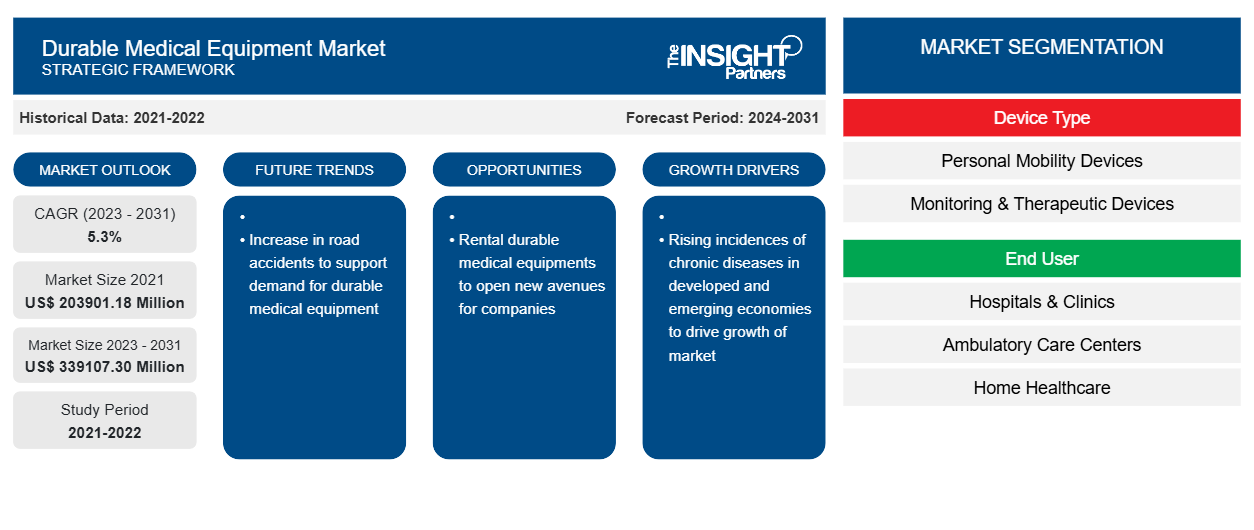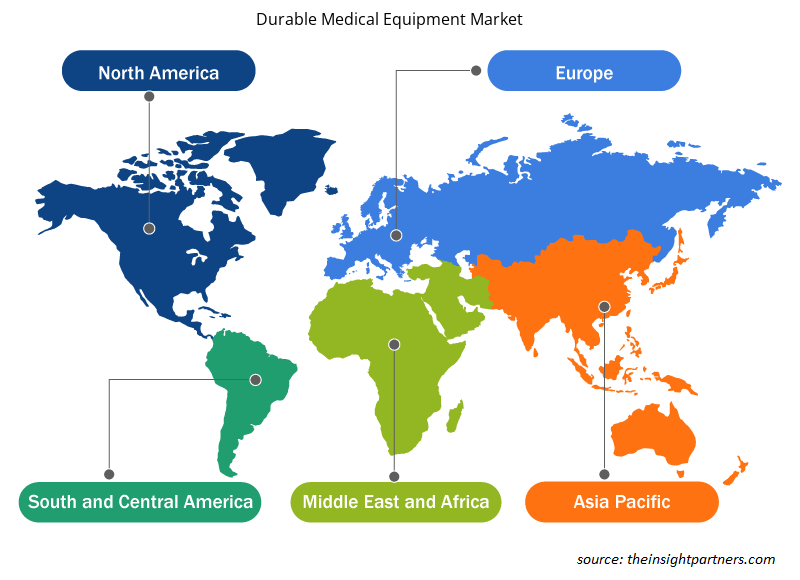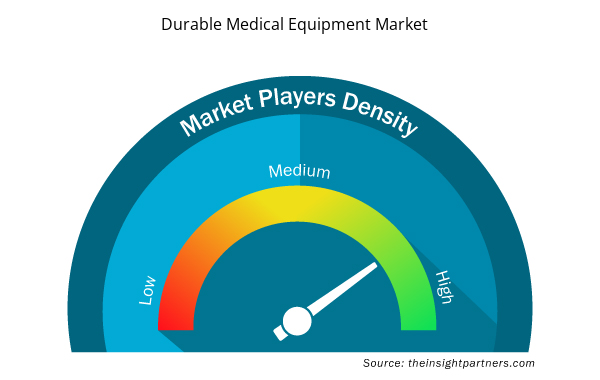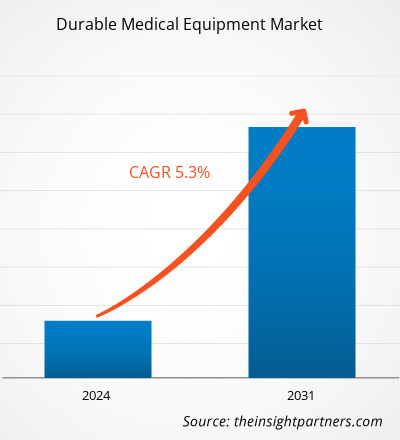The Durable Medical Equipment Market size was estimated to be US$ 203901.18 million in 2021 and US$ XX million in 2023 and is expected to reach US$ 339107.30 million by 2031; it is estimated to record a CAGR of 5.3% in till 2031. The market's growth is attributed to key driving factors such as the increasing prevalence of chronic diseases such as diabetes, cardiovascular diseases, obesity, and stroke, the increasing geriatric population, and growing incidents of road accidents. Such factors are likely to remain key Durable Medical Equipment Market trends.
Durable Medical Equipment Market Analysis
According to the Centers for Disease Control and Prevention (CDC) report 2018, approximately 9% of the population had diabetes, a leading cause of kidney failure and lower-limb amputations in the U.S. Also, the data suggest that nearly 1.5 million Americans are diagnosed with diabetes every year in the U.S. Cardiovascular diseases (CVD) account for 45.0% of all deaths in Europe and 37.0% of all deaths in the E.U. CVD is the primary reason for death in men and women in all countries. Therefore, a rise in the incidences of CVDs is likely to increase the demand for cardiovascular diagnostic devices, propelling the growth of the durable medical equipment market during the forecast period. Diabetes is becoming a life-threatening disease with no functional cure. It is primarily caused by the body’s inability to produce or utilize insulin. Diabetes is among the most common global health casualties of the 21st century. The incidence rate has increased significantly, leading to life-changing complications.
Rising cases of chronic diseases in both developed and emerging economies are driving the growth of durable medical equipment market.
Durable Medical Equipment Market Overview
Durable medical equipment (DME) is the utilities or devices that can be used for an extended period, which enables a patient to carry out daily activities. This equipment is used alone or can be used along with other devices for monitoring or therapeutic purposes. The products considered DME include personal mobility devices such as wheelchairs, walkers, and scooters and diagnostic devices like cardiac and blood glucose monitors. Monitoring devices help analyze a patient’s physiological parameters, such as blood pressure, heart rate, blood sugar, pulse rate, blood oxygen levels, and vital signs. These devices play a significant role as they help reduce patient hospitalization time and hospital visits. Therapeutic devices help treat respiratory diseases, cardiac conditions, and metabolic disorders like diabetes. Common therapeutic devices available in the market include infusion pumps, nebulizers, and oxygen equipment. The demand for DME has been rising due to the prevalence of chronic disorders such as sleep apnea, respiratory and cardiovascular diseases, and diabetes.
Global durable medical equipment market is segmented by region into North America, Europe, Asia Pacific, the Middle East & Africa, and South & Central America. In North America, the US is the largest market for durable medical equipment. The growth of the durable medical equipment market in North America can be attributed to the rising prevalence of chronic disorders, the increasing geriatric population, and the rise in awareness programs. As per Canadian Lung Association, 26% of Canadian adults 18 years and above are at a higher risk of sleep apnea. The condition is among the underdiagnosed respiratory disease prevalent in Canada. Additionally, Continued Positive Airway Pressure (CPAP) therapy is the most common therapy for patients with sleep apnea. Therefore, there is an increase in CPAP therapy equipment in the country.
Customize This Report To Suit Your Requirement
You will get customization on any report - free of charge - including parts of this report, or country-level analysis, Excel Data pack, as well as avail great offers and discounts for start-ups & universities
Durable Medical Equipment Market: Strategic Insights

- Get Top Key Market Trends of this report.This FREE sample will include data analysis, ranging from market trends to estimates and forecasts.
You will get customization on any report - free of charge - including parts of this report, or country-level analysis, Excel Data pack, as well as avail great offers and discounts for start-ups & universities
Durable Medical Equipment Market: Strategic Insights

- Get Top Key Market Trends of this report.This FREE sample will include data analysis, ranging from market trends to estimates and forecasts.
Durable Medical Equipment Market Drivers and Opportunities
Increasing number of road accidents to Favor the Overall Market
A significant increase in road accidents has increased the demand and supply of durable medical equipment during the forecast period. As per the estimates by the CDC, road traffic injuries are the eighth driving cause of death worldwide and are estimated to be the seventh driving cause of death by 2030. Injuries caused due to road accidents lead to deformities, amputations of limbs, fractures of bone, and severe pain in the different parts of the body. Other conditions caused due to injuries include spinal cord paralysis, head-brain injuries, facial disfigurement, and wrist and arm injuries. Personal mobility devices such as wheelchairs, walkers, canes, and crutches are advised for individuals recovering from these road accidents. Such a trend is likely to drive the overall durable medical equipment market during the forecast period.
Home Healthcare Market is Expected to Propel the Market Demand – An Opportunity of Durable Medical Equipment Market
Durable medical equipment(DME) can help maintain safety and a sense of independence, especially for the elderly or the geriatric population. They mainly provide support post-surgery at home or any healthcare settings. Four of the most common types of DME are shower chairs, bed rails, walkers and Hoyer lifts. These pieces can be expensive to purchase, and sometimes, renting them is a better use of resources.
Such advancements in recent years is likely to generate attractive growth opportunity for the durable medical equipment market.
Durable Medical Equipment Market Report Segmentation Analysis
Key segments that contributed to the derivation of the Durable Medical Equipment Market analysis are device type and end user.
- Based on the device type, the Global Durable Medical Equipment Market is bifurcated into personal mobility devices and monitoring & therapeutic devices. The monitoring & therapeutic devices segment led a larger market share in 2023 and is expected to retain its dominance during the forecast period from 2024 to 2031. In the devices type segment, the personal mobility device market is growing at a higher CAGR during the forecast period. A personal mobility device is an assistive device that helps transport an individual. These devices are used by individuals who have limited or restricted mobility. These devices are available in variants and can be operated manually and powered by a battery. Per the report's scope on the durable medical equipment market, personal mobility devices include wheelchairs, scooters, walkers & rollators, canes & crutches, and other personal mobility devices. Similarly, monitoring and therapeutic devices include blood glucose monitoring devices, infusion pumps market, nebulizers, oxygen equipment, continuous positive airway pressure (CPAP), and cardiovascular devices. Monitoring devices analyzes a patient’s physiological parameters such as blood pressure, heart rate, blood sugar, pulse rate, blood oxygen levels, and vital signs. These devices play a significant role as they help reduce patient hospitalization time and hospital visits.
- Based on end-users, the durable medical equipment market was segmented into hospitals & clinics, ambulatory care centers, and home healthcare. The hospitals & clinics segment held the largest share of the market in 2023. However, the home healthcare segment is expected to grow at the fastest rate in the coming years owing to a rising preference for home care settings for managing various medical conditions since it reduces the time required for regular checkups and restricts the cost associated with hospital visits. In addition, the market is also segmented based on segments offered by the leading participants in the industry to understand widely used market-specific terminologies. For instance, personal mobility devices include wheelchairs, scooters, walkers & rollators, canes & crutches, and other personal mobility devices. Similarly Monitoring & Therapeutic Devices segment includes blood glucose monitors, vital signs monitoring devices, infusion pumps, nebulizers, Oxygen Equipment, Continuous Positive Airway Pressure (CPAP), and cardiovascular devices.
Durable Medical Equipment Market Share Analysis by Geography
The geographic scope of the Durable Medical Equipment Market report is mainly segmented into five regions: North America, Asia Pacific, Europe, the Middle East & Africa, and South America/South & Central America.
The Asia Pacific durable medical equipment market is expected to be the fastest-growing regionduring the forecast period. The region consists of the countries such as China, India, Japan, Australia, South Korea, and Rest of Asia Pacific. China holds the largest market share in this segment. China is regarded as an aging society, and the demand for related medical devices is expected to increase. By 2030, over 230 million people in China will be 60 or over. The growth of the market is categorized by an increasing number of market players involved in research and development activities. For instance, in January 2018, the global first clinical case of the MitralStitch mitral valve repair system, developed by Hangzhou DeJin Medtech Co., Ltd. (an affiliate company of DiNovA Medtech) was completed at Yunnan Fuwai Hospital, China.
Durable Medical Equipment Market Regional Insights
The regional trends and factors influencing the Durable Medical Equipment Market throughout the forecast period have been thoroughly explained by the analysts at Insight Partners. This section also discusses Durable Medical Equipment Market segments and geography across North America, Europe, Asia Pacific, Middle East and Africa, and South and Central America.

- Get the Regional Specific Data for Durable Medical Equipment Market
Durable Medical Equipment Market Report Scope
| Report Attribute | Details |
|---|---|
| Market size in 2021 | US$ 203901.18 Million |
| Market Size by 2031 | US$ 339107.30 Million |
| Global CAGR (2023 - 2031) | 5.3% |
| Historical Data | 2021-2022 |
| Forecast period | 2024-2031 |
| Segments Covered |
By Device Type
|
| Regions and Countries Covered | North America
|
| Market leaders and key company profiles |
Durable Medical Equipment Market Players Density: Understanding Its Impact on Business Dynamics
The Durable Medical Equipment Market is growing rapidly, driven by increasing end-user demand due to factors such as evolving consumer preferences, technological advancements, and greater awareness of the product's benefits. As demand rises, businesses are expanding their offerings, innovating to meet consumer needs, and capitalizing on emerging trends, which further fuels market growth.
Market players density refers to the distribution of firms or companies operating within a particular market or industry. It indicates how many competitors (market players) are present in a given market space relative to its size or total market value.
Major Companies operating in the Durable Medical Equipment Market are:
- Invacare Corporation
- Medtronic
- BD
- Hillrom Services Inc
- Medical Depot, Inc
- GF HEALTH PRODUCTS, INC.
Disclaimer: The companies listed above are not ranked in any particular order.

- Get the Durable Medical Equipment Market top key players overview
Durable Medical Equipment Market News and Recent Developments
The Durable Medical Equipment Market is evaluated by gathering qualitative and quantitative data post primary and secondary research, which includes important corporate publications, association data, and databases. The following is a list of developments in the market for durable medical equipment and strategies:
- In November 2022, Cardinal Health launched Velocare, a supply chain network that will provide hospital-level critical products and services for home care (Source: Cardinal Health, Press Release, 2022)
Durable Medical Equipment Market Report Coverage and Deliverables
The “Durable Medical Equipment Market Size and Forecast (2021–2031)” report provides a detailed analysis of the market covering below areas:
- Market size and forecast at global, regional, and country levels for all the key market segments covered under the scope
- Market dynamics such as drivers, restraints, and key opportunities
- Key future trends
- Detailed PEST/Porter’s Five Forces and SWOT analysis
- Global and regional market analysis covering key market trends, major players, regulations, and recent market developments
- Industry landscape and competition analysis covering market concentration, heat map analysis, prominent players, and recent developments
- Detailed company profiles
- Historical Analysis (2 Years), Base Year, Forecast (7 Years) with CAGR
- PEST and SWOT Analysis
- Market Size Value / Volume - Global, Regional, Country
- Industry and Competitive Landscape
- Excel Dataset



Report Coverage
Revenue forecast, Company Analysis, Industry landscape, Growth factors, and Trends

Segment Covered
Device Type and End User

Regional Scope
North America, Europe, Asia Pacific, Middle East & Africa, South & Central America

Country Scope
US, Canada, Mexico, UK, Germany, Spain, Italy, France, India, China, Japan, South Korea, Australia, UAE, Saudi Arabia, South Africa, Brazil, Argentina

 Get Free Sample For
Get Free Sample For